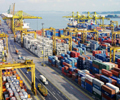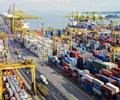

The not-yet-operational Tuas port is already being used to store containers, as Singapore ports, operating 24/7, dig into their reserves to help tackle the global supply chain disruption.
The logistical nightmare has been the result of manpower shortages and port closures elsewhere caused partly by Covid-19 restrictions, and an increase in demand for goods as repressed consumers start spending again after the pandemic eased.
Still-open ports like Singapore have been faced with congestion, with the number of containers stuck in transit awaiting shipment surging.
The 2,000 TEUs (20-foot equivalent units) in yard capacity that opened at Tuas port last month is in addition to another 65,000 TEUs in storage space which was rolled out in Keppel terminal late last year. The unit refers to the dimensions of a standard shipping container.
This is even as more than 2,500 locals were added to the maritime workforce, boosting the number of port workers by around 20 per cent.
Senior Minister of State for Transport Chee Hong Tat said on Wednesday (Oct 20) that Singapore is trying its best to help cargo ships make up for lost time, and more yard space can be made available when necessary.
“We have become the go-to port for shipping lines to catch up on lost time and connections, and also to untangle some of their operational challenges. We are not just a catch-up port, but also a one-stop shop, where we offer a range of different services to the shipping lines… such as bunkering, supplies, crew change,” he added.
These services are not costless to Singapore.
“When we do that, while it helps to reduce the overall delays of global supply chains… boxes stay in our yards much longer than before. As more ships come to Singapore to make use of our one-stop service and catch-up service, it does also add on to the queues and the waiting times (here),” Mr Chee said.
At a media conference to address the nation’s response to the shipping crisis, he said people have to be realistic about what the country can do as just one player in a complex global network.
He noted that Singapore cannot completely solve the logjam although, as an important transshipment hub – the straits of Malacca and Singapore account for a third of world seaborne trade – it can work to reduce the extent of the problem.
“Through proactive planning, effective communication and enhanced productivity, our aim is to help them catch up on their delayed vessel schedules, shorten the transit time of boxes and fulfil more cargo connections,” Mr Chee said.
“(Taking on this bigger role) is a conscious move based on longer-term strategic considerations and because we recognise our global responsibility as a key transshipment hub port.”
Singapore was named the world’s top shipping hub in the 2021 Xinhua-Baltic International Shipping Centre Development Index last year, beating other trade nodes like London, Shanghai, Hong Kong and Dubai. It remains the world’s busiest container transshipment and bunkering hub.
But beyond increasing port operations, PSA Singapore has expedited the movement of more critical materials, including semiconductors that are used in the manufacture of electronic parts utilised in anything from health to communications devices.
The port operator is also working with small and medium-sized enterprises to make sure cargo flows from China to Singapore stay punctual enough for them to meet their project deadlines.
It has also been examining other joints along the supply network, and has been providing data and advice to shipping companies and cargo owners on how to plan their routes better.
“If we are able to share this information with other stakeholders within the ecosystem, everyone has better visibility and can do better planning and coordination,” Mr Chee said.
The supply chain disruption has ignited concerns that higher material and shipping costs will create inflationary pressures worldwide, even as economies everywhere make tentative recoveries from the coronavirus crisis.
The Monetary Authority of Singapore last week tightened its monetary policy, an earlier-than-expected adjustment which signalled the central bank’s concern at cumulative external and domestic pressures on the cost of living.
Mr Chee said it is difficult to assess what the overall impact on other goods the supply crisis, which has so far most adversely impacted higher-value products, will have.
But Singapore has widened its supply sources, including for food. “The more diversified, the more wide-ranging our supply sources are, the greater the confidence that will be in terms of being able to withstand any cyclical source disruption,” he added.
Source: The Straits Times